World War II did not end on either 8 or 9 May 1945. Despite signing formal agreements, regular fights with the Wehrmacht continued. How long and why?
Gottlob Bidermann wasn't anything special, but he was unlucky enough to go east in 1941 with the 132nd Wehrmacht Infantry Division. "He did not serve in an elite unit, but in anonymous formations whose successive numbers resemble entries in a telephone book," said Dennis Showalter, author of the introduction to his memoirs, bluntly.
This does not mean, however, that it is an irrelevant division. Bidermann, along with the rest of the formation, participated, for example, in 1942 in the six-month siege of Sevastopol - a bloody slaughterhouse in which one hundred thousand of his companions were killed. In the last phase of the fighting, he fought in the vicinity of Leningrad, and finally landed with a decimated division in Courland. And Courland landed in the cauldron.
Katyn raises morale
“By order of the Army Group Commander North, it was forbidden to use the term, Curland cauldron. There were rumors, although to my knowledge nothing of the sort had never happened, that any soldier who spoke about the hopelessness of our position in the "cauldron" would be brought before a firing squad. Since the destruction of the 6th Army at Stalingrad, the word "cauldron" has taken on an ominous meaning, heralding an imminent, inevitable catastrophe.
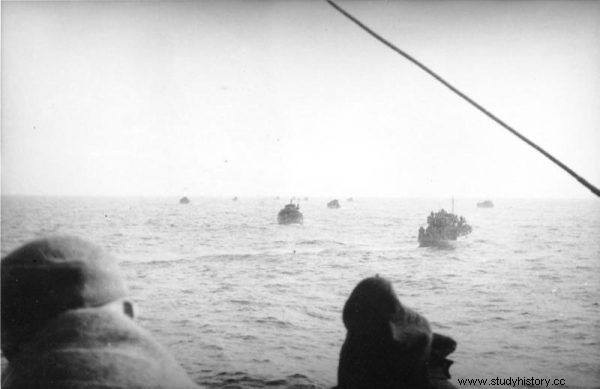
German refugees crossing the Baltic Sea. In 1945 civilians were evacuated from the Courland boiler by sea.
However, the publication of such an order, even among the most optimistic, who still clung to the hope of a final victory, has now awakened the awareness of the utter hopelessness of our situation. Nevertheless, it must be emphasized that the will to fight the Soviets and the fighting spirit of the soldiers in Courland remained unwavering, "Bidermann recalled and did not lie.
The location of the German troops was significantly hopeless at the time. From the fall of 1944, German troops were tightly surrounded by Red Army troops, which tried to capture this relatively small area in several large offensives. For quite unclear reasons, Hitler did not allow the evacuation, although strategically the Courland campaign did not bind the enemy forces so much that it could have a real impact on stopping the enemy's momentum in the main theater of the war.
"This is how the great dying in Courland began," commented fighter Hans Schäufler. But Bidermann was also right when he wrote about the exceptionally strong morale of the Germans in this region. Despite the overwhelming Russian forces and their practically unlimited possibilities of replenishing equipment and people, the Wehrmacht troops put up constant and effective resistance. The reports on this subject, sent on the eve of Germany's official surrender, are unambiguous. For example:
3.04.45:In Courland, numerous attacks by the Soviets northwest of Doblen are failing to achieve the desired success.
4.04.45:Northwest of Doblen, the Soviet attack collapses
5/4.45:In Courland, repeated attacks by the Soviets northwest of Doblen are not successful.
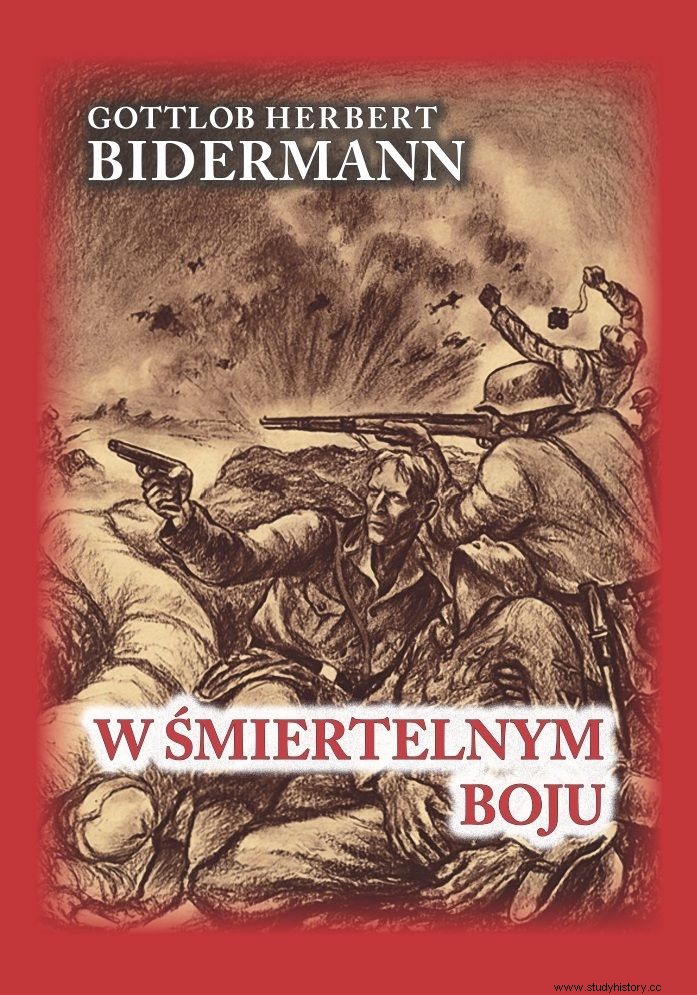
The article was inspired by the book by Gottlob Herbert Bidermann "In mortal battle. Diaries of a German soldier from the Eastern Front ”(Finna 2017). Buy with a discount on bonito.pl.
How it was in practice, relates Schäufler:“On October 27, the first great defensive battle began in Courland. The Soviet armies began a fire raid of 2,000 guns, whose missiles fell for hours on the German positions between Tukums and Liepaja, which formed a 200-kilometer front line. For four weeks, the Latvian ground trembled under the blows of a mighty battle; smoke and flames engulfed this fortress on the Baltic Sea.
However, as a result of the brave defense of the German troops, the plans of the Soviets ended in a fiasco for them and enormous losses. On November 3, the Oberkommando der Wehrmacht was able to inform that »In the area east of Liepaja, thanks to the unparalleled attitude of our troops, which destroyed 62 enemy tanks, the Soviet attempt to break our defense lines was stopped ... In total, the enemy lost tanks in Courland in October 1944« . For a moment, the Soviets lost their momentum. There was silence over the earth torn by grenades and bombs, which in the rain slowly turned into a sea of mud. Both sides suffered heavy losses.
Our troops were exhausted from fighting almost to the breaking point. And yet, on November 25, Soviet divisions attacked again, throwing unimaginable amounts of resources into the battle, this time on German defenses in the area between Priekule and the Ventspils River. Defensive fights lasted until December 7. But also in this section the Soviets did not manage to break the German defense. This battle entered military history under the name of the Second Battle of Courland. ”
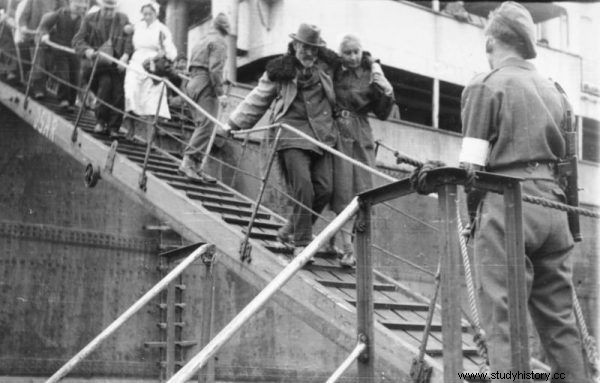
German refugees disembark from a ship in a port occupied by British troops.
It sounds a bit like cheap boasting and emphasizing the chivalry of the German spirit, but the fact is that there were six similar Courland battles then, and none proved victorious for the Russians. This is interesting because Bidermann's recollections show that the news of Hitler's death “most of the soldiers felt relieved” - so they were not fanatical Nazis ready to give their lives for the Leader. When, after the surrender, Russian officers asked Bidermann the question:"Why? Why have you been fighting for so long? After all, Hitler has long been dead. " He replied pathetically, "Because we are soldiers."
The truth, however, was perhaps a bit more down-to-earth. There were two reasons for the long resistance of the Germans in Courland, to which Bidermann admits between the lines. First of all - Katyn. At least in this section of the front, even the rank and file of the Wehrmacht heard about this crime and were simply sure of the same fate. So they preferred to die fighting, the more - and this is the second reason - that the rumor circulated quite intensively in the ranks that they would soon be evacuated by the Allies and used to fight on a common front with the Russians. It was not unfounded. The British did not disband three German armies in Schelwig-Holstein for the next six months precisely because of the potential Third World War ...
This explains why the last fighting in Courland continued until May 13, even though most troops had surrendered as ordered five days earlier.
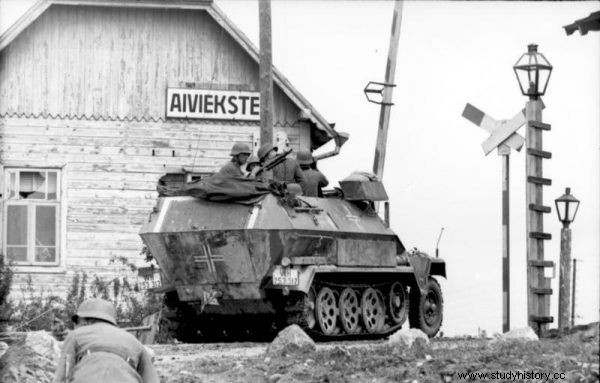
The German army in Latvia, in 1941, a few years before the start of the desperate retreat of the army of the Third Reich.
The weather gives up last
Nothing is known about similar rumors in Poland, but the fact is that it was not until May 13 that the last German troops entrenched in the Vistula Spit surrendered, and on May 11 those located in Hel. Their story was in a way connected with that of Bidermann. Both Courland and Polish Pomerania were attacked by the Russians in one action, the so-called East Prussian Operation. Wehrmacht soldiers, who in May 1945 found themselves on the Vistula Spit, were mostly survivors, survivors and evacuated after the fights for Królewiec, which had fallen a month earlier, on April 9.
They were extremely exhausted - nearly 40,000 Germans died during these fights and more than twice as many were captured. So their desperation was astonishing. They set up a barricade made of locomotives on the Spit, which was to stop the Russian tanks, but could not stop the planes, the raids of which were much more intense than the attack of the land forces. As in Courland, most troops formally surrendered on May 9. The desperate ones, however, managed to withstand the impetus of the attack for four more days.
At that time, the Germans also fought in the Czech Republic. May 6, when the so-called There were still nearly a million of them in the Prague operation, they had 10,000 guns, 2,000 tanks and a thousand aircraft - the fact that they were remnants of the Middle Army does not change the fact that they were still a serious force. At least enough to successfully suppress spontaneous uprisings, such as the Prague Uprising on May 5, 1945, which, although supported by the Russian Liberation Army of Andrei Vlasov, quickly collapsed.
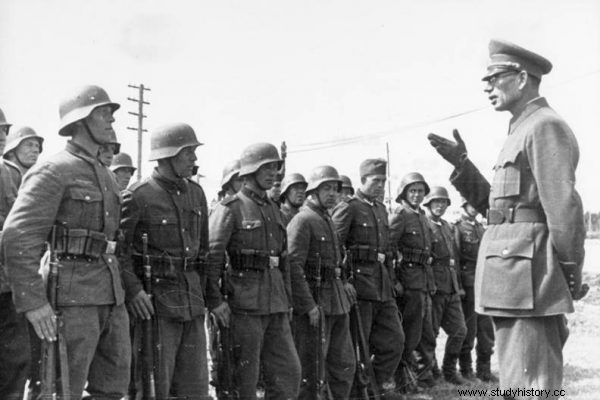
General Vlasov together with the soldiers of the collaborative Russian Liberation Army - ROA.
Despite the rapid progress of the Red Army and the formal ceasefire, Field Marshal F. Schörner refused to stop fighting. Lieutenant Waldemar Gajewski, company commander in the 1st Armored Brigade, which was then marching with the Russians of the 2nd Polish Army, recalled:“However, not everyone could celebrate this day joyfully and carefree. In the Sudetenland region, the command of the army group "Centrum" did not obey the surrender and did not want to lay down their arms. To prevent this from happening and ultimately break down the enemy, the actions continued. " They ended at the same time as the fighting on the Vistula Spit and in Courland, with the capture of Mielnik on May 13, 1945.
But when Mielnik fell, the shots in Europe did not stop. About one and a half thousand kilometers south was the final episode in the history of the German E-Army commanded by General von Lehr. On May 3, she had to quickly withdraw from Trieste, conquered by the joint forces of the Italian armed underground, the Yugoslav army of Josip Tito and the Allied New Zealand forces. However, this was not a panic withdrawal.
At that time, the Wehrmacht's forces of nearly 300,000 were twice as large as those of the Yugoslavs, but still constituted a punitive army capable of disciplined operations. And certainly better commanded and armed. The Yugoslav forces consisted mainly of fresh recruits with makeshift weapons, and if they were soldiers with experience, they were only guerrilla fights, not open combat.
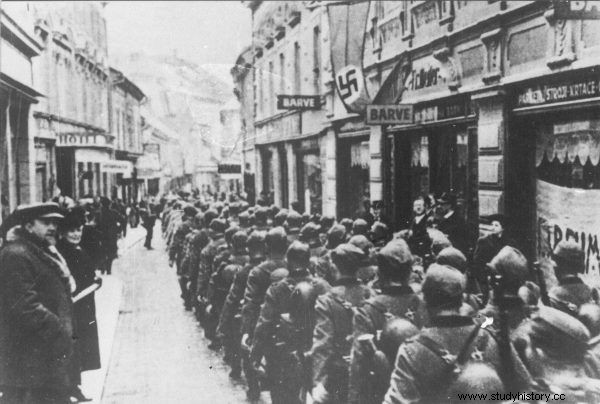
German soldiers marching through Maribor in 1941.
Indeed, only a numerical advantage can explain the fact that on May 4, after the "dramatic assault of the semi-armed infantry on the organized defense of the Germans" at Vinkovce, the army of von Lehr decided to retreat towards Austria and surrender to the Allied forces there. But it was not a desperate retreat. Regular fights also took place in Maribor (May 10) and Dravograd (May 12), only to stop on May 15. The Allies refused to accept von Lehr's troops and an army of nearly three hundred thousand ended up in the camps of Tito's troops.
Even then, there were territories in Europe occupied by the Germans and somewhat forgotten by the Allied forces. The word territories may sound a bit too serious. The Norman islands in question ranged from a few (Sark) to a maximum of one hundred (Jersey) square kilometers, and although they were strategically located in the middle of the English Channel, few people cared about them. Even the inhabitants themselves, for whom the German occupation was almost imperceptible ... The only things that were forbidden were leaving the house after 11 PM, drinking alcohol in public and leaving the island.
There were no Gestapo, no executions and no arrests. Only on Alderney, a concentration camp was organized, and the remaining islands were included in the Atlantic Wall - bunkers and observation towers were built, and artillery batteries were also placed, although rather weak and outdated. In reality, the islands did not pose a military threat to the more serious forces. Not surprisingly, despite the official surrender on May 9, Alderney, eight square kilometers, did not surrender until a week later, on May 16. She had no one before.
However, for the last chord of World War II in Europe, we had to wait until June 11, 1945, when the two-person staff of the German weather station in Spitsbergen surrendered.
Buy with a discount on bonito.pl

